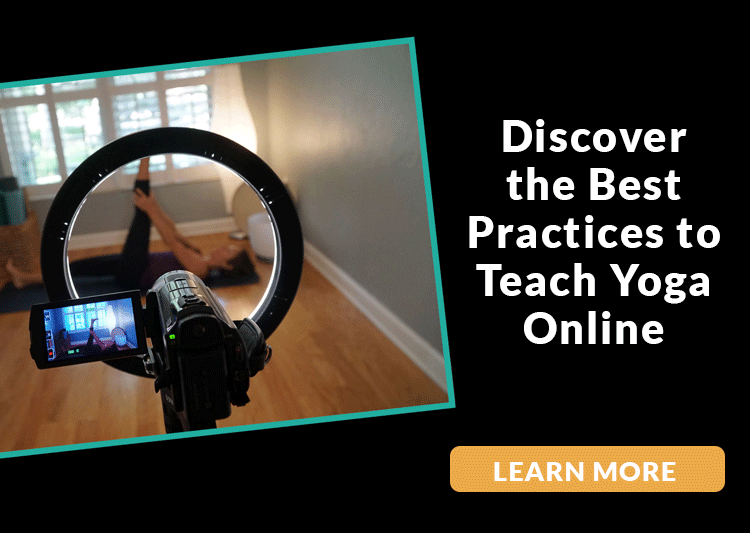 Graduating from a 200-hour yoga teacher training is simultaneously exhilarating and terrifying. You love yoga and you’re excited to share it with others. Yet, you may not be sure your skills match your passion and you likely haven’t been taught the best ways to attract new clients. This blog post will provide answers to new yoga teacher FAQs. With the clarity you gain, you can confidently embrace your role as a leader as well as understand the next best steps to make this dream a reality.
Graduating from a 200-hour yoga teacher training is simultaneously exhilarating and terrifying. You love yoga and you’re excited to share it with others. Yet, you may not be sure your skills match your passion and you likely haven’t been taught the best ways to attract new clients. This blog post will provide answers to new yoga teacher FAQs. With the clarity you gain, you can confidently embrace your role as a leader as well as understand the next best steps to make this dream a reality.
I get that the global COVID-19 restrictions might complicate this for you right now.
But here’s a bit of truth. There will always be an excuse to remain in your comfort zone. You can easily blame any challenge when you’re not ready to change.
Thankfully yoga stands the test of time as an effective way to energize the body, balance emotions, and generate well-being throughout your entire system. And in a society that’s stressed-out, burned-out, anxious, and disconnected, there is more need than ever for yoga right now. There is a pressing demand for your unique voice to show the way.
I know it helps to have a plan in place to do this. That’s why I teach the 5 basic elements of building a yoga business in this online workshop. It gives you a step-by-step path that will help you find, and get, great clients (even if you’re teaching part-time or as a volunteer). The FAQs below are ones from new teachers that have taken this program. May these answers serve you as well as it has them!
Photo Credit: Rokas
TEACH YOGA ONLINE
Q: How does a person get started teaching online classes?
A: First, decide if…
You are going to teach live or post recorded classes. Next, decide the platform on which you will teach (such as Zoom, YouTube, Vimeo, Teachable (or other online resource). Then decide if you will be teaching for free or getting paid.
Above all else, you will want a market to take your classes. This means finding potential clients. You can do this by purchasing ads online or with social media. You can network with other companies who also serve your target market group (or ideal client). You can also start to think like your client and find out where they hang out and start to meet them where they’re at.
Q: What are common mistakes made by teachers online?
A: There are so many …
Common mistakes that I created an entire online workshop to teach virtually like a pro. I’ll sum up a few of those errors here:
First, many online teachers have their mat positioned at an improper angle to the camera. This makes it difficult for students to see your movements on the screen. To prevent this, turn the long-edge of your yoga mat perpendicular to the camera.
Second, teachers don’t have enough lighting in their teaching space. Ideally you want natural light behind the camera, or off to the side at the very least. If you don’t have windows in your room, then you can purchase these studio lights to help. I use them in my own studio even though I do have windows in place already. The added brightness makes visibility, and ultimately learning, more enjoyable for students.
Third, many teachers show their crotch to students before their face. This is because optimal camera height is the same as your hips. This means that when teachers turn on their camera, you see their private parts first. I suggest you counter this by investing in a remote control. That, or have a loved one at home press the record button for you. It’s small, thoughtful details you put in place when teaching online that set you apart as the professional you are!

GET PAID TO TEACH
Q: How much should an average yoga teacher at a studio expect to get paid?
A: There are numerous ways to get paid:
You can get paid per student, flat rate, or base rate plus a certain amount per student. The last of these incentivises teachers to grow their audience. I have seen pay scales at $5-6 per student, or a $5-25 base rate. I’ve also witnessed a $10-15 base rate + $2-7 per student after meeting a base minimum. Rates vary based on what the market will bear in any area. This is just an idea.
Q: What kind of expenses-to-profit ratio should a typical studio expect to make?
A: The kind of profit you make as a yoga business varies.
I have witnessed yoga businesses making anywhere from 5% – 30% profit. Some who are all virtual can be even more than that. I suggest you check out the Benchmark report for stats. They collect data from lots of different studios and consolidate that information.

MARKETING
Marketing is the system you have in place to find, and keep, great clients. This may sound daunting at first. Yet we have a whole article, and worksheet, about marketing strategy basics to get you started.
Q: How do I get a student base being a new teacher with no yoga studio support?
A: This answer is similar to …
Finding potential clients for online classes above. You want to find out:
- where your idea clients spend their time, attention, and money (online and in your community)
- discover who serves them already
- network with those existing companies to serve that group of individuals
- offer free samples of what you do to build trust (volunteer, share at community events, provide online samples)
- have marketing material online and in your community
- marketing material can include advertising on social platforms, too.
Q: How do you best pair online payment with a scheduling app?
A: Marketing encompasses more than finding new clients.
It involves the steps to bring those new students into the fold of your community. Payment is part of this process.
So there are two parts to this question. First, you want to be able to take payment as easily as possible. Said another way, you want students to be able to pay for your classes and offers easily. Venmo, Paypal, and Stripe are companies that help with this. Stripe integrates with lots of website platforms like Leadpages, Squarespace, Kajabi, WordPress and many others to make payment from your website very easily. Venmo and Paypal also have some integration features.
Along with payment for your products, students want to know how to sign up for your classes. They need to enroll just as easily once payment has been made. Once you have integrated the payment process with your website, you want to ensure a scheduler is in place.
Acuity Scheduling is my personal favorite for students to sign up, as it’s easy-to-use and extremely affordable. Plus it integrates with ZOOM to make sending links to your students for online classes really easy. Ubindi is another tool mentioned by other teachers in the industry, although I have not worked with it personally. MindBody and ZenPlanner are also other admin platforms that can integrate payment and scheduling (although they have varying degrees of integration with the actual app you will use to teach your online) Fitgrid is also an integration that allows students to get Zoom links after payment, although it’s pricey.
BUSINESS LOGISTICS
There are many logistical elements you want to have in place when you start teaching yoga. In addition to the answers below, you can get our new yoga teacher checklist to simplify the start-up process.
Q: What are reasonable liability insurance companies for yoga instructors?
A: You have a wide selection of yoga insurance companies to choose from.
Here are just a few that are reputable:
Q: Do I need insurance if you just volunteer teaching yoga?
A: Business logistics vary by state and country.
I would check the requirements in your specific state. However, I would highly suggest that you have a policy if you are teaching yoga in any capacity. It’s an inexpensive way to insure you minimize your risk should someone overextend themselves in your class.
Q: Which type of yoga insurance should you carry?
A: This depends on your personal asset value …
And your goals as a professional. This article about yoga insurance gives more insight about the companies above as well as types of insurance to carry. Keep in mind that many companies are now covering teachers as they work in a remote format.
PUTTING IT TOGETHER
Take the fear and uncertainty out of being a new yoga teacher by increasing your knowledge about the professions. The answers to the FAQs of new yoga teachers above is a start. Our online learning programs, like our Yoga Business Basics Workshop and Launch Your Yoga Business course, add more clarity to the process.
Don’t see your burning question above?
Send us your question now, let us answer it, and post it publicly in this article for others to learn as well.
Take Action Now:
- Set an intention for yourself as a yoga teacher. Once you know what and why you want to teach, you’ll have more momentum to bring your vision to life.
- Learn more about the yoga industry and avoid the pitfalls that many new teachers make as they get started.
- Save time, energy, and money as you start this journey. Our online courses are designed to help you do just that, so join us now and start with focus!








Leave A Comment